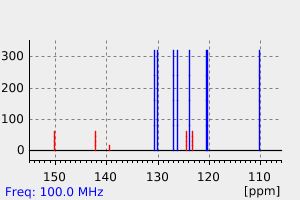9-(9'-acridyl)carbazole
中文名称
——
中文别名
——
英文名称
9-(9'-acridyl)carbazole
英文别名
9-(9H-carbazol-9-yl)acridine;9-carbazol-9-ylacridine
CAS
——
化学式
C25H16N2
mdl
——
分子量
344.415
InChiKey
MHUIYPXRENZOOZ-UHFFFAOYSA-N
BEILSTEIN
——
EINECS
——
-
物化性质
-
计算性质
-
ADMET
-
安全信息
-
SDS
-
制备方法与用途
-
上下游信息
-
文献信息
-
表征谱图
-
同类化合物
-
相关功能分类
-
相关结构分类
计算性质
-
辛醇/水分配系数(LogP):6.6
-
重原子数:27
-
可旋转键数:1
-
环数:6.0
-
sp3杂化的碳原子比例:0.0
-
拓扑面积:17.8
-
氢给体数:0
-
氢受体数:1
反应信息
-
作为产物:描述:2-氨基苯甲醛 在 copper(l) iodide 、 硫酸 、 potassium carbonate 、 caesium carbonate 、 溶剂黄146 作用下, 以 二丁醚 、 二甲基亚砜 为溶剂, 反应 48.5h, 生成 9-(9'-acridyl)carbazole参考文献:名称:2-氨基苯甲醛,具有生物活性的a啶和a啶的常见前体摘要:从共同的底物2-氨基苯甲醛开始,制备了cr啶和a啶酮。前者是通过铜催化的N-芳基化反应,然后进行酸介导的环化反应而以高收率产生的,而后者是通过双重铜催化的N-芳基化,然后在相同反应条件下环化。此外,a啶通过依赖于锂锌碱进行去金属化并转化为相应的4-碘衍生物,其与吡咯烷酮和吡唑参与铜催化的偶联。最后,将吡唑,吲哚和咔唑添加到裸a啶的9位上得到改善。虽然在黑素瘤细胞生长抑制中注意到了适度的生物学活性,但新制备的化合物具有有趣的光物理性质,这些性质在初步研究中已进行了评估。DOI:10.1016/j.tet.2020.131435
文献信息
-
Solid State Bimolecular Photoreaction in a Simple Polycrystalline Mixture of Acridine and Carbazole作者:Hideko KoshimaDOI:10.1080/10587250108023726日期:2001.2.1Irradiation of a simple polycrystalline mixture of acridine and carbazole gave a condensation product as a sole product.
-
On the TICT Mechanism of 9,9′-Biaryl Compounds作者:Javier Catalán、Cristina Díaz、Vicenta López、Pilar Pérez、Rosa María ClaramuntDOI:10.1002/(sici)1099-0690(199808)1998:8<1697::aid-ejoc1697>3.0.co;2-w日期:1998.8The UV/Vis absorption and fluorescence spectra for 9,9'-biacridinyl (BAC) and 9-(9'-acridyl)carbazole (C9AC) were recorded in approximately 50 different solvents. The analysis of the solvatochromic behaviour of the two chromophores, in terms of both polarity and polarizability (SPP), revealed that TICT emission in C9AC prevails only in solvents with SPP greater than or equal to 0.63, while that in BAC predominates throughout the solvent range studied [from 2-methylbutane (SPP = 0.479) to DMSO (SPP = 1.0)]. The peculiar behaviour of BAC suggests that the chromophore requires no cooperation from the solvent to trigger its TICT mechanism. Various hypotheses usually employed in analysing the TICT mechanism of biaryl compounds, including model emissions used to deconvolute spectra, the variation of TICT emission with the difference in redox potential between the chromophores involved, etc., are discussed.
-
Boyer, Gerard; Claramunt, Rosa M.; Elguero, Jose, Journal of the Chemical Society. Perkin transactions II, 1993, # 4, p. 757 - 766作者:Boyer, Gerard、Claramunt, Rosa M.、Elguero, Jose、Fathalla, Mohamed、Foces-Foces, Concepcion、et al.DOI:——日期:——
-
DMITRIEVA, L. L.;SARAULOVA, G. I.;KUROV, G. N., VINITI 1853-B作者:DMITRIEVA, L. L.、SARAULOVA, G. I.、KUROV, G. N.DOI:——日期:——
表征谱图
-
氢谱1HNMR
-
质谱MS
-
碳谱13CNMR
-
红外IR
-
拉曼Raman
-
峰位数据
-
峰位匹配
-
表征信息
同类化合物
(S)-4-(叔丁基)-2-(喹啉-2-基)-4,5-二氢噁唑
(SP-4-1)-二氯双(喹啉)-钯
(E)-2-氰基-3-[5-(2,5-二氯苯基)呋喃-2-基]-N-喹啉-8-基丙-2-烯酰胺
(8α,9S)-(+)-9-氨基-七氢呋喃-6''-醇,值90%
(6,7-二甲氧基-4-(3,4,5-三甲氧基苯基)喹啉)
(1-羟基-5-硝基-8-氧代-8,8-dihydroquinolinium)
黄尿酸 8-甲基醚
麻保沙星EP杂质D
麻保沙星EP杂质B
麻保沙星EP杂质A
麦角腈甲磺酸盐
麦角腈
麦角灵
麦皮星酮
麦特氧特
高铁试剂
高氯酸3-苯基[1,3]噻唑并[3,2-f]5-氮杂菲-4-正离子
马波沙星EP杂质F
马波沙星
马来酸茚达特罗杂质
马来酸茚达特罗
马来酸维吖啶
马来酸来那替尼
马来酸四甲基铵
香草木宁碱
颜料红R-122
颜料红210
颜料红
顺式-苯并(f)喹啉-7,8-二醇-9,10-环氧化物
顺式-(alphaR)-N-(4-氯苯基)-4-(6-氟-4-喹啉基)-alpha-甲基环己烷乙酰胺
非那沙星
非那沙星
青花椒碱
青色素863
雷西莫特
隐花青
阿莫地喹-d10
阿莫地喹
阿莫吡喹N-氧化物
阿美帕利
阿米诺喹
阿立哌唑溴代杂质
阿立哌唑杂质B
阿立哌唑杂质38
阿立哌唑杂质1750
阿立哌唑杂质13
阿立哌唑杂质
阿立哌唑杂质
阿尔马尔
阿加曲班杂质43







